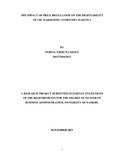| dc.description.abstract | Kenya experienced sharp increase in prices of petroleum products between 2007 and 2010. It
was observed that oil firms were taking advantage of international price changes to exploit
the public. Due to the public outcry and the need to protect consumers the government
through its agency the Energy Regulatory Commission came up with a way of regulating
pump prices by setting the maximum prices that oil marketers are to charge.
The study sought to establish the impact of regulation of oil pump prices on the profitability
of oil marketing companies in Kenya. The study used causal research design and gross
margin as set by the Energy Regulatory Commission was used as the control factor. The
study used secondary sources of data from audited financial statements and management
reports. The performance of companies before and after introduction of price control was
analyzed using profitability ratios. Gross profit margin and return on capital employed were
calculated to establish the profitability of oil companies. Data collected was analyzed using
Microsoft Excel 2007 and presented in tables and line graph. Regression analysis on ROCE
and gross profit margin was done, trend analysis of gross profit margin before and after
introduction of price regulation was also done.
From the regression analysis, a comparison of (R2) showed49% of ROCE for Total Kenya
was explained by changes in gross profit margin in 2010 and 60% in 2011 and 2012, 49% in
2010 and 74% in 2011 and 2012 for Kenol Kobil. Hass Petroleum recorded (R2) of 97% in
2010 and 91% in 2011 and 2012. There was however a decrease in (R2) for NOCK after
introduction of price regulation, 23% was recorded in 2010 and 2% in 2011 and 2012.An
analysis of the movement of annual gross margin ratio before and after price regulation
showed decline in gross profit margin from the year 2010 to 2013 for Kenol Kobil, National
Oil Corporation of Kenya and Hass Petroleum. Total Kenya gross profit margin reduced to
5.1% in 2011 from 8.3% recorded in 2010 and improved marginally in 2012 to 5.5%.
The study results showed that regulation on oil pump prices had a negative impact on the
profitability of oil marketing companies. The study recommended the Energy Regulatory
Commission and Oil Marketing Companies to consult further to improve suitability and
applicability of the formula in order to protect the profitability of the sector. | en |

